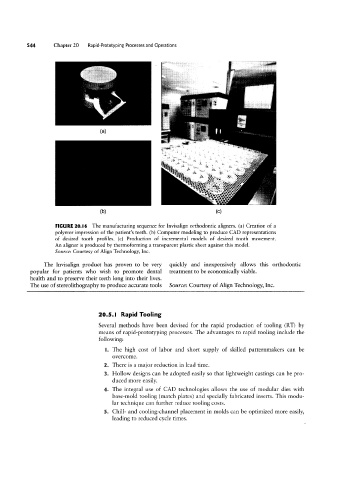Page 564 - 04. Subyek Engineering Materials - Manufacturing, Engineering and Technology SI 6th Edition - Serope Kalpakjian, Stephen Schmid (2009)
P. 564
544 Chapter 20 Rapid-Prototyping Processes and Operations
Z.,
Q Q, tt* =~ a f
,H 'ri .ww .. x, .,, ;_f
`“` 4 'V-¢ 1, ». _QQ ‘5’~
;»»» -~ Qt
;£¢ ‘Z v
“ -:K "zz..; _ N
#ag .. J §~., ; W, --, , _‘
~*' ~a~ .
ea-~ QW
(D) (C)
FIGURE 20.l6 The manufacturing sequence for Invisalign orthodontic aligners. (a) Creation of a
polymer impression of the patient’s teeth. (b) Computer modeling to produce CAD representations
of desired tooth profiles. (c) Production of incremental models of desired tooth movement.
An aligner is produced by thermoforming a transparent plastic sheet against this model.
Source: Courtesy of Align Technology, Inc.
The Invisalign product has proven to be very quickly and inexpensively allows this orthodontic
popular for patients who wish to promote dental treatment to be economically viable.
health and to preserve their teeth long into their lives.
The use of stereolithography to produce accurate tools Source: Courtesy of Align Technology, Inc.
20.5.I Rapid Tooling
Several methods have been devised for the rapid production of tooling (RT) by
means of rapid-prototyping processes. The advantages to rapid tooling include the
following:
I. The high cost of labor and short supply of skilled patternmakers can be
overcome.
2. There is a major reduction in lead time.
3. Hollow designs can be adopted easily so that lightweight castings can be pro-
duced more easily.
4. The integral use of CAD technologies allows the use of modular dies with
base-mold tooling (match plates) and specially fabricated inserts. This modu-
lar technique can further reduce tooling costs.
5. Chill- and cooling-channel placement in molds can be optimized more easily,
leading to reduced cycle times.

